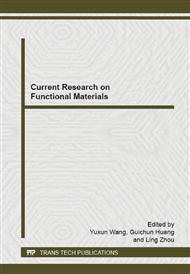[1]
J. H. Jiang, H. Wang, L. F. Zhu, et al. Photocatalytic activity of Ag-ZnO-TiO2 coupled semiconductor and its kinetics, J. Technology of Water Treatment, 37(2011) 30-33.
Google Scholar
[2]
H. X. Li, J. Zhu. Preparation of photocatalysts with tailored structures and their correlation to the photocatalytic efficiency, J. Chin J Catal, 29 (2008) 91-98.
Google Scholar
[3]
J. N. Yao. Optical catalyst research and prospect of the development, R. The development of the 2002 high technical report of Chinese Academy of Sciences. Beijing, Science Press. (2002).
Google Scholar
[4]
L. Gao, S. Zheng, Q. H. Zhang. Nano titania photocatalytic materials and applications, M. Beijing, Chemical Industry Press, (2003).
Google Scholar
[5]
R. Nosrati, A. Olad, R. Maramifar, Degradation of ampicillin antibiotic in aqueous solution by ZnO/polyaniline nanocomposite as photocatalyst under sunlight irradiation, J. Environ Sci Pollut Res, 19 (2012) 229-2299.
DOI: 10.1007/s11356-011-0736-5
Google Scholar
[6]
A. Mclaren, T. Valdes-Solis, G. Q. Li, S. C. Tsang, shape and size effects of ZnO nanocrystals on photocatalytic activity, J.Journal of the American Chemical Society, 131 (2009) 12540-12541.
DOI: 10.1021/ja9052703
Google Scholar
[7]
K. E. Karakitson, X. E. Verkios. Effects of altervalent cation doping of titania on its performance as a photocatalyst for water cleavage, J. Phys Chem, 97 (1993) 1184-1189.
DOI: 10.1021/j100108a014
Google Scholar
[8]
W. Choi, A. Termin, M. R. Hoffmann. The role of metal ion dopants in quantum-sized TiO2: correlation between photoreactivity and charge carrier recombination dynamics, J. Phys Chem, 51, 98 (1994) 13669-13679.
DOI: 10.1021/j100102a038
Google Scholar
[9]
R. Asahi, T. Morikawa, T. Ohwaki, et al. Visible-light photocatalysis in nitrogen-doped titanium oxides, J. Science, 5528, 293 (2001) 269-271.
DOI: 10.1126/science.1061051
Google Scholar
[10]
S. T. Han, H. L. Xi , R. X. Shi, et al. Prospect and progress in the semiconductor photocatalysis , J. Chinese Journal of Chemical Physics. 5, 16 (2003) 339-349.
Google Scholar
[11]
I. L. Marta. Heterogeneous photocatalysis transition metal ions in photocatalytis systems, J. Appl Catal B, 2~3, 23 (1999) 89-114.
Google Scholar
[12]
Y. Bessekhouad, D. Robert, J.V. Weber. Bi2S3/TiO2 and CdS/TiO2 heterojunctions as an available configuration for photocatalytic degradation of organic pollutant, J. Photochem Photobiol A: Chem. 163 (2004) 569-580.
DOI: 10.1016/j.jphotochem.2004.02.006
Google Scholar
[13]
D. C. Cronemeyer. Infrared Absorption of Reduced Rutile TiO2 Single Crystals, J. Phys Rev, 50, 113 (1959) 1222-1226.
Google Scholar
[14]
A. Hernández, L. Maya, E. Sánchez-Mora, E. M. Sánchez. Sol-gel synthesis, characterization and photocatalytic activity of mixed oxide ZnO-Fe2O3, J. Sol-Gel Sci Technol, 42 (2007) 71-78.
DOI: 10.1007/s10971-006-1521-7
Google Scholar
[15]
S. F. Chen, W. Zhao, W. Liu, S. J. Zhang. Preparation, characterization and activity valuation of p-n junction photocatalyst p-ZnO/n-TiO2, J. Applied Surface Science. 255, 5 (2008) 2478-2484.
DOI: 10.1016/j.apsusc.2008.07.115
Google Scholar
[16]
Z. G. Hu, M. Y. Duan, M. Xu. Electronic structure and optical properties of ZnO doped with Fe and Ni, J. Acta Phys. Sin. 58, 2 (2009) 1166-1172.
Google Scholar
[17]
Z. G. Hu, X. Zhou, M. Xu. Preparation and properties of ZnO thin films doped with Fe and Ni by sol-gel method, J. Journal of Synthetic Crystals. 39(2010) 257-261.
Google Scholar
[18]
Z. H. Wu, M. Xu, W. Q. Duan. Effects of Fe doping on the crystal structures and photoluminescences of ZnO: Ni thin films prepared by sol-gel method, J. Acta Phys. Sin. 61(2011) 1175.
DOI: 10.7498/aps.61.137502
Google Scholar
[19]
T. H. Fu, Q. Q. Gao, P. Liu, et al. Preparation of (Fe, Ni)-codoped ZnO and its photocatalytic activity for degradation of methyl orange, J. Chinese Journal of Catalysis. 31 (2010)797.
DOI: 10.3724/sp.j.1088.2010.91220
Google Scholar
[20]
J. K. Jia, L. Luo, W. Zhang, et al. Room temperature ultraviolet stimulated emission of ZnO nanocrystals, J. Spectroscopy and Spectral Analysis[J]. 2010, 30(9), 2525.
Google Scholar
[21]
K. C. Barick, Sarika Singh, M. Aslam, D. Bahadur. Porosity and photocatalytic studies of transition metal doped ZnO nanoclusters, J. Microporous and Mesoporous Materials. 134 (2010) 195-202.
DOI: 10.1016/j.micromeso.2010.05.026
Google Scholar
[22]
A. Azam, F. Ahmed, N. Arshi, M. Chaman, A.H. Naqvi. Formation and characterization of ZnO nanopowder synthesized by sol-gel Method, J. Journal of Alloys and Compounds. 496 (2010) 399-402.
DOI: 10.1016/j.jallcom.2010.02.028
Google Scholar
[23]
X. Y. Deng, M. F. Lv, Z. L. Cui. Characterization of nanosized ZnO by thermal analysis, J. Journal of Qingdao University of Science and Technology. 27 (2006) 228.
Google Scholar
[24]
W. C. Li, G. T. Du, X. T. Yang, et al. XPS valence band of ZnO films, J. Hemial Journal of Hinese Universities. 25(11) (2004) P2078.
Google Scholar
[25]
G. D. Khattak, M. A. Salim. X-ray photoelectron spectroscopic studies of zinc-tellurite glasses, J. Journal of Electron Spectroscopy and Related Phenomena. 123 (2002) 47-55.
DOI: 10.1016/s0368-2048(01)00371-1
Google Scholar
[26]
S. Linic, P. Christopher, D. B. Ingram. Plasmonic-metal nanostructures for efficient conversion of solar to chemical energy, J. Nature Materials, 10 (2011) 911-921.
DOI: 10.1038/nmat3151
Google Scholar
[27]
R. Wahab, S. G. Ansari, Y. S. Kima, G. Khang, H. S. Shin. Effect of hydroxylamine hydrochloride on the floral decoration of zinc oxide synthesized by solution method, J. Applied Surface Science, 254 (2008) 2037-(2042).
DOI: 10.1016/j.apsusc.2007.08.038
Google Scholar
[28]
S. Kant, D. Pathania, P. Singh, P. Dhiman, A. Kumar. Removal of malachite green and methylene blue by Fe0. 01Ni0. 01Zn0. 98O/polyacrylamide nanocompositeusing coupled adsorption and photocatalysis[J]. Applied Catalysis B: Environmental. 2014, 147: 340-352.
DOI: 10.1016/j.apcatb.2013.09.001
Google Scholar


